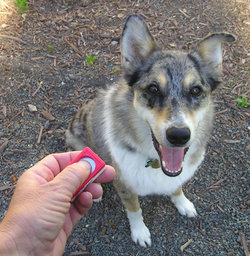|
From Wikipedia the free encyclopedia, by MultiMedia |
 Most Dogs love it when the clicker comes out.
Most Dogs love it when the clicker comes out.Clicker training is the process of training an animal using a conditioned reinforcer, such as a clicker, to mark a desired behavior, thereby indicating to the animal being trained that it has done something correct. It was originally used in training animals for which traditional methods of obedience training weren't useful, such as dolphins in wild-animal shows or carrier pigeons used for specific military purposes. The animal is first presented with a sound and immediately given the reward, which can be a special treat, or a toy. The animal learns to associate the noise with the reward. Once the noise is conditioned, it is then used to reinforce positive behaviors that the trainer wishes the animal to repeat.
One of the challenges in training an animal is in letting it know when it has done the behavior that the trainer is attempting to reinforce. As a simple example, when teaching a Dog to shake hands, the first step would be to encourage the Dog simply to lift one paw. At the instant that the Dog raises the paw, the trainer must let the Dog know that it has done the correct thing. However, the traditional "good Dog!" takes so long to say that the Dog might already have lowered the paw again before realizing that it is being praised. In addition, people's voices, pronunciation, tone, loudness, and emphasis, and how long it takes to say the words can change, even at different minutes of the same training session, so that the animal has to learn to interpret through all of the nuances to understand what the trainer is attempting to convey.
A clicker solves these problems. It produces a very short sound that can be initiated and completed at the instant the behavior occurs. The sound is always identical - same volume, same tone, same length. While operant conditioning is the formal terminology for clicker training, it is known colloquially as clicker training because of the use of the clicker/cricket. Note though, that it is not necessary to use a clicker to train a Dog or other animal with operant conditioning techniques. Any device that can make a uniform sound and can be activated quickly (such as the click of a pen cap or the blow of a whistle) will work.
The first step in clicker training is to teach the animal that the clicker sound means that they will get a reward. To do this, the trainer does what is called "loading the clicker." Over a few sessions, the trainer clicks the clicker and immediately thereafter gives the animal a reward (usually a treat to start with; later, favorite toys can be substituted), clicks again and rewards again, and so on for about 20 repetitions each session. Dogs, for example, learn the association very quickly.
After that, the trainer can use the clicker to begin marking desired behaviors; each time that the animal performs the behavior, the trainer clicks and, quickly thereafter, rewards. The primary key to clicker training is the trainer's timing; clicking slightly too early or too late can quickly establish an incorrect association in the animal's mind.
Karen Pryor, a scientist with an international reputation in the fields of marine mammal biology and behavioral psychology, is widely heralded as a founder of clicker training.
Many desired behaviors start with the nose-touch, where the Dog learns to touch an identified target, such as a small piece of plastic, with its nose; that behavior can then be transported to perform useful tasks or interesting tricks such as flipping a lightswitch or ringing a bell to go outside.
Training the nose touch begins with getting the Dog to touch a target with its nose; trainers sometimes use a guided method, such as placing a dab of peanut butter on a small plate or plastic target; others prefer shaping, where the target is placed in easy reach, such as in the trainer's hand between the trainer and the Dog, and the Dog is rewarded each time he moves in the target's direction or actually touches it.
When the Dog is consistently touching the target, the trainer progresses to a target with and without food and in different positions. Eventually, the trainer can transfer the behavior to a bell, for example by holding the target behind the bell so that the Dog has to touch the bell to get at the target, and then rewarding the touching of the bell. When the Dog is reliably touching the bell, the trainer now adds the act of opening the door to the reward each time the Dog strikes the bell.
Dogs, made by MultiMedia | Free content and software
This guide is licensed under the GNU Free Documentation License. It uses material from the Wikipedia.